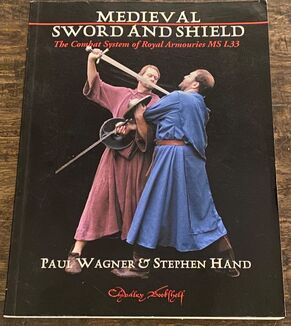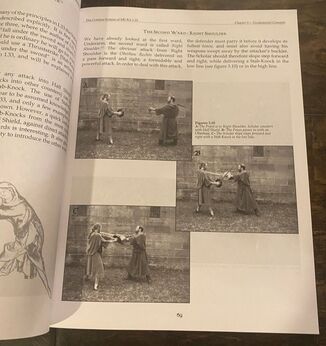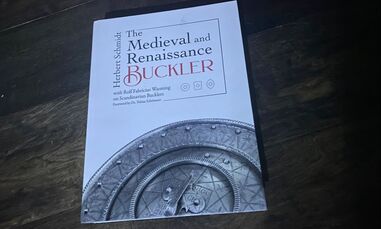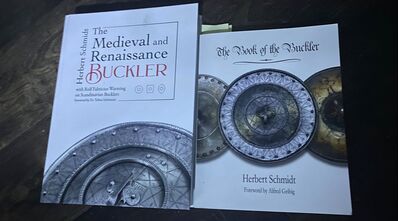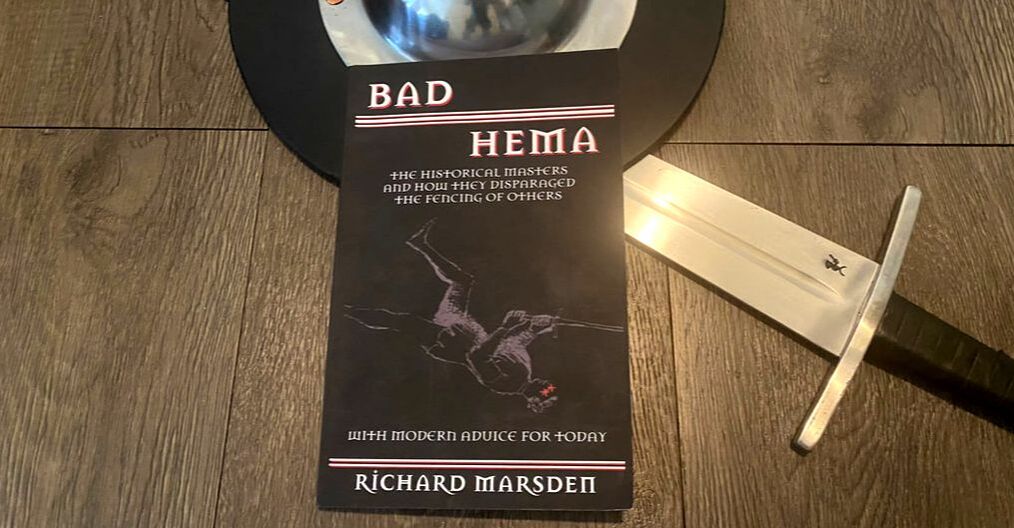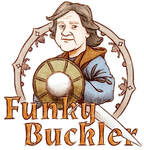|
Today, we will be reviewing Paul Wagner’s and Stephen Hand’s book titled Medieval Sword & Shield: The Combat System of Royal Armouries MS I.33. This book, published in 2003, covers their interpretation of the I.33 techniques. I will primarily focus on the book’s value as an interpretation source for new fencers getting started with I.33. I will focus on three major areas: structure, presentation of techniques, and value. I will not comment on the interpretation itself. The validity of the interpretation is up to the reader to decide as they journey down their own research on I.33. StructureWagner and Hand start their book with basic gear for training as well as fundamentals of swordsmanship, such as distance and footwork. They then move into fundamental concepts of I.33, such as the wards and the counters to the wards. The book then discusses the actions that can be performed from each ward, starting with the first one and ending with the more advanced wards. The book also includes a conclusion and a summary of the following steps to continue on your journey to understanding I.33. I believe this structure works for teaching I.33 and gives a ward-first perspective into the techniques. The organization inherently emphasizes footwork first, which is incredibly important in swordsmanship, regardless of the weapon. Unfortunately, when the techniques are grouped by ward, it can be a challenge for newer fencers to relate what they are reading in the interpretation to the manuscript itself. However, this is mitigated by the fact that Wagner and Hand include a large number of images, which can help fencers relate what they are learning to the manuscript. Presentation of TechniquesUnfortunately, while the images in the manuscript help the reader relate to the manuscript, they also mask some of the techniques and body mechanics. This is because Wagner and Hand chose to wear baggy tunics, as depicted in I.33. The authors do address their rationale for this choice. They believe it is critical to interpret the techniques in the clothing of the time because clothing, especially footwear, can impact technique. I fully support Wagner and Hand's sentiment, but the tunics mask their body movements, which can lead to challenges in replicating their techniques. One advantage these images do have is the way in which they were taken. The pictures were taken in a clear field with a simple background which makes it clear what to focus on when analyzing the images in the book. The quantity of the pictures and how they are laid out in the book alongside the text also makes it very easy to follow the rationale and flow of their interpretation. ValueThis book can be found for around $50.00 used when writing this blog. It does not appear that this book is still in print, which means the price will continue to increase. The book has a soft cover but a thick binding, which helps preserve the book. The book is a quality soft-cover book, and the weight of the pages adds both durability and ease when trying to study from the book and then practice the techniques. Who I Recommend It ToUnfortunately, this is a difficult book to recommend to new fencers due to the difficulty in finding affordable copies. There are other books currently in print that can be used to start learning I.33. However, this book is one of the earliest HEMA I.33 interpretations and is a great book to have in your collection if you’re interested in the evolution of I.33 interpretations. It is clear that Wagner and Hand put a large amount of effort into their interpretation and the book they produced is clear and concise when presenting their interpretation of I.33.
0 Comments
Today we will be reviewing Herbert Schmidt’s latest book titled The Medieval and Renaissance Buckler. The book covers topics on the buckler including typologies, history, carrying, construction, and many others. This book also includes a chapter by Rolf Fabricius Warming that covers some topics on Scandinavian bucklers. In this blog, I will discuss both The Medieval and Renaissance Buckler and the previously published the Book of the Buckler. Given the same author and subject matter, I feel that it is necessary to compare the two works in order to give an accurate assessment of the newer The Medieval and Renaissance Buckler. SummarySchmidt begins the book by defining what a buckler is. He then transitions to exploring the history of the buckler. Next, Schmidt defines the typology of bucklers to further classify the different shapes and designs of bucklers through history. The book also includes sections on the usage of the buckler, construction of the buckler, carrying of the buckler, and a large catalogue of historical bucklers found in museums. One of the newest features of The Medieval and Renaissance Buckler is the inclusion of history and analysis of Scandinavian bucklers and Khevsureti bucklers. The inclusion of this topic allows for the book to expand to more targeted cultural studies of buckler use that was not seen in the earlier published the Book of the Buckler. This is not a book for learning about how to use a buckler and this is clearly stated in the forward by the author. The book touches on the usage of the buckler but from a 50,000 ft view. It touches on a range of different sources including fencing manuscripts and art depicting skirmishes and war in the middle ages. Thoughts on the BookAs an amateur researcher of sword and buckler, I find Herbert Schmidt’s research invaluable for understanding the historical context of the buckler. One of his best contributions to me has been his typology of bucklers which helps contextualize how the shapes of bucklers can impact combat. Thankfully, his work on buckler typology can be found in both books. What cannot be found in his previous book is the research on Scandinavian and Khevsureti bucklers. While these two sections are brief, about 20 pages, they provide fascinating points of view on the relevancy of the buckler. In future works, I would love to see this section expanded to other cultures, including Mamluk’s use of the buckler, to help contextualize variables in bucklers by culture. I find that often the history of the buckler is somewhat oversimplified with sweeping research on European bucklers. The inclusion of culturally-specific buckler use is a fantastic step in the right direction to really exploring the variety of bucklers and how they were used. CostAs of writing this blog, the book is listed on Amazon for $76.91 hardback. Unfortunately, a paperback version is not available but the catalogue of the bucklers can be purchased for $47.76. The book is about 446 pages with about a fifth of the book dedicated to research and the remainder consisting of the catalogue of bucklers. In contrast, the 262 page the Book of the Buckler can be purchased in paperback from Wyvern media for about $35.91 plus shipping. To my knowledge, a hardback version is not available. Comparing the Value of Both Books The increase in value of this book is most noticeable with the expansion of the buckler catalogue which is now 300 pages, compared to the catalogue in the Book of the Buckler, which was around 150 pages. This catalogue includes more pictures and better measurement data that is beneficial in studying bucklers. It even managed to impress my dog "Crouton". While short, the Scandinavian and Khevsureti buckler is a nice addition to the book that adds both scholarly content, and pictures that are enjoyable to the reader. This inclusion feels like frosting on the cake of Herbert Schmidt’s research. However, it is worth noting that the two books vary little in the content not included in the catalogue or Scandinavian and Khevsureti sections. In addition, Verbiage has been updated and there is a feeling of an overall facelift. Ultimately, if you own the Book of the Buckler then about a fifth of the research in The Medieval and Renaissance Buckler and about half of the catalogue will already be in your library. However, the updated catalogue can be purchased separately. Overall, I view The Medieval and Renaissance Buckler as the second edition of a buckler textbook. More information has been added, the catalogue has grown, and the prior information has been revised to sharpen its clarity. This is evident in the exclusion of the Google nGram analysis of sword and buckler references in literature. I contacted the author regarding the change and his response was “I removed it because I learned that Google's nGram is a bit unreliable.” This shows the evolution of Schmidt’s research and further establishes in my mind that this new book is a Second Edition of his research. Who I Recommend the Book toIs The Medieval and Renaissance Buckler worth the nearly $40 price increase over the Book of the Buckler? In my opinion, yes but only for the audience I believe this book is targeted towards. This book is not for people that do not care about the history, construction, or usability of bucklers and only care about the fencing systems that use bucklers. This book is comparable to a history textbook, which may not be worth it for everyone given the price. However, this book is a great addition to any library for those that are curious about historical bucklers and what we know about them based on art, literature, and surviving artifacts. I have found Herbert Schmidt’s buckler research comparable to Ewart Oakeshott’s research on swords. I have cited Herbert Schmidt’s work numerous times in my own work and hope that his typologies will become standard practice in referencing types of bucklers like we do with Oakeshott’s categorization of swords. However, if you want more examples and images of bucklers but already own the Book of the Buckler and are not interested in the cultural studies on bucklers included in this new book, I recommend skipping this book and picking up the catalogue of bucklers by Herbert Schmidt. I have not picked up the catalogue book personally but if it is one-to-one with the catalogue in The Medieval and Renaissance Buckler then it will be worth the money. Suppose you own the Book of the Buckler, which satisfies your curiosity about the buckler and are not interested in the new additions to the catalogue. In that case, you may consider skipping this new book. As mentioned earlier, the bulk of the research has been refined but has not changed from the Book of the Buckler in many ways. Just be aware that you are using a research book's first edition, which may become obsolete as time goes on. Closing ThoughtsTo me, The Medieval and Renaissance Buckler is best summarized as the second edition of the Book of the Buckler. I wonder if the inability to call it a second edition is due to the change in publisher. I would love to see Herbert Schmidt and others continue to come back to this research and continue refining them like textbooks. I think versioning of this book would go a long way in clearly telling potential buyers that this is a revision, not completely brand new content.
That being said, I am VERY satisfied with the latest book. I love the addition of cultural studies on bucklers and the growth in the buckler catalogue is incredibly beneficial to me for understanding what examples of bucklers exist in museums. I plan to give my copy of the Book of the Buckler to one of my students. The first edition of Herbert Schmidt’s research is still valid and while some of the evidence to support the buckler research may have changed, the spirit and content of the historical study has not deviated from the original book. That being said, The Medieval and Renaissance Buckler is an expansion on the original research found in the previous book and I view it as the new gold standard on the topic of historical bucklers. Today we will be reviewing one of the newest HEMA related books by Richard Marsden titled Bad HEMA the historical masters and how they disparaged the fencing of others. We will be exploring the general overview of the book as well as cost and who I would recommend the book to. SummaryMarsden starts by exploring notable fencing masters and what they believed was bad practice in swordsmanship. Many popular fencing masters and their opinions are analyzed including (but not limited to) Johannes Liechtenauer, Fiore dei Liberi, Joachim Meyer, Giacomo di Grassi, George Silver, Salvator Fabris, and Miyamoto Musashi. Next, Marsden categorizes the bad practices established in the first section of the book as “Universally Bad” and “Contentious Fencing”. In some cases, many of the fencing masters agree that some techniques are bad. In other cases, such as the discussion of cut verses thrust, the masters are split. The last section of Bad HEMA explores what modern practitioners of swordsmanship can learn from the past regarding bad techniques. This section includes advice from other modern HEMA practitioners on their experiences in HEMA and what they have learned. CostAs of writing this blog, the book can be purchased on Amazon for $19.99 in paperback and $29.99 in hardback. The book is 122 pages excluding the bibliography and acknowledgements. This makes Bad HEMA one of the shorter books in the catalogue of books on HEMA and swordsmanship. AccessibilityThis book is an incredibly easy read and accessible for all levels of experience in HEMA. I read this book in one sitting and walked away feeling like I had learned quite a bit about former fencing masters and HEMA as a whole. I purchased the book in paperback and I feel like I made the right choice. This is a compact sized book that fits well in a backpack or even just carried around. I believe that a hardback copy of this book would slightly take away from the ease of carry. However, I am also the type of person who enjoys the cost savings of paperbacks. Who I Recommend It To Even for its relatively short length, this book packs a lot of historical information in it. The information provided in this book appears relevant for all HEMA practitioners; whether they are experienced or not. The most valuable part of this book is the comparison of many fencing masters on what they believe is bad practice. I appreciate the ability to have one reference to a topic from 15 different fencing masters all in one conveniently small book. As an added bonus, the book includes sections on the personal experience of other HEMA practitioners. While not all of the advice is relevant to all HEMA fencers, all HEMA fencers will get something out of the concluding section of this book. Closing ThoughtsThis is a great book for all practitioners of swordsmanship. At the price, this book is a must have.
Bad HEMA does something different than many other HEMA related books. Instead of deep diving into the interpretation of a system, the book explores a single topic across many different systems popular in HEMA. Furthermore, with the inclusion Miyamoto Musashi, the book expands outside of the typical HEMA sources to reinforce the claims of “universally bad” practices. I hope this book can springboard into a whole new genre of swordsmanship-related topics to explore the universal truths of swordsmanship. |
Proudly powered by Weebly
